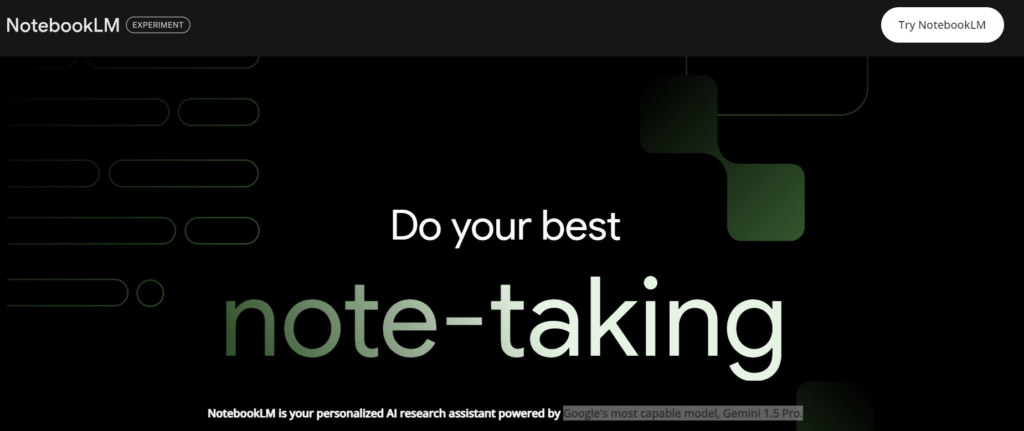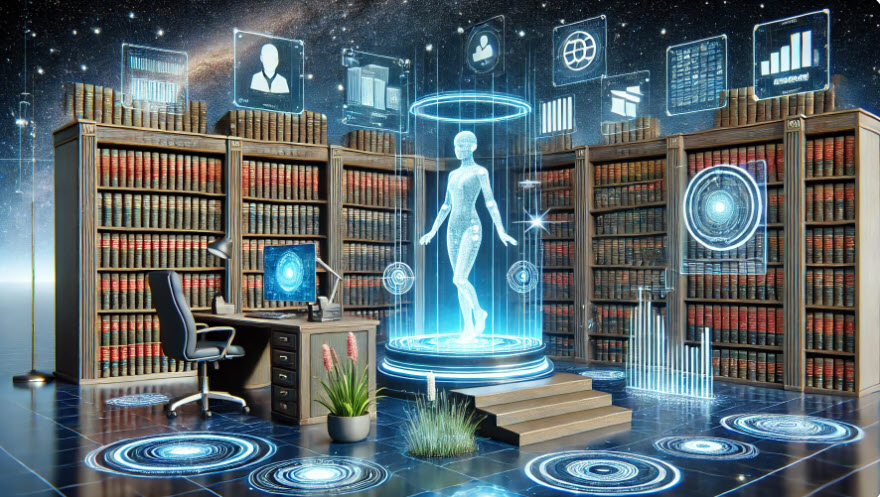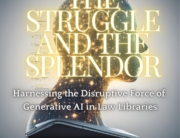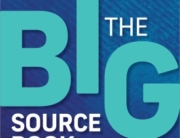NotebookLM is an exciting new (and free!) AI application modeled on Google’s generative AI model, Gemini 1.5 Pro, that will create briefing documents, FAQs, timelines, study guides, tables of contents, and even a podcast based on your content!
After signing up for an account with NotebookLM, you can create different notebooks made up of documents that you can upload directly from your own files from your computer, your Google Drive, by linking to a website, or just by pasting in text. You can include up to 50 different sources. You can then select which sources you’d like Notebook LM to analyze and create notes for you in the form of all of those different document types. You can also just chat with your notebooks of sources similar to a RAG modeled, domain-specific chatbot!

I uploaded my previous presentations on AI: Prompt Engineering & Chatbots in Law Libraries and 15 Ways Law Libraries can use Generative AI as well as my recent article, The Struggle and the Splendor: Harnessing the Disruptive Force of Generative AI in Law Libraries to create my “AI” notebook in NotebookLM. I then clicked “FAQ” and this is what it created for me based on those documents:
FAQ: Generative AI in Law Libraries
1. What is Generative AI (GAI) and how is it relevant to law libraries?
Generative AI refers to a category of artificial intelligence (AI) that focuses on creating new content, such as text, images, music, and even code. GAI tools are transforming the legal field and law libraries by automating tasks, streamlining research, and offering innovative solutions for legal professionals. Law librarians can leverage GAI for various purposes, including legal research, document review and analysis, instructional design, metadata support, and creating marketing content.
2. What are some examples of how GAI can be used for legal research?
GAI tools can revolutionize legal research in several ways:
- AI-Assisted Research: GAI can conduct research and provide citations from legal databases, saving researchers time and effort.
- Editorial Enhancements: Some GAI-powered tools offer features like summarizing legal documents, extracting key findings, and highlighting relevant precedents.
- Idea Generation: GAI can help broaden or narrow research topics by suggesting related keywords, concepts, and areas of law.
3. Can GAI help with creating instructional materials for law libraries?
Yes, GAI can assist in designing engaging and informative instructional materials for library patrons and staff. Here are some examples:
- Lesson and CLE Syllabus Design: GAI can generate lesson plans and course syllabi for workshops and training sessions.
- Presentation Creation: Tools like Gamma.app can transform simple prompts into comprehensive slide decks for lectures and presentations.
- Interactive Content: GAI can help develop interactive tutorials, quizzes, and even learning games to enhance the educational experience.
4. How can GAI be utilized for marketing and promoting law library services?
GAI offers creative solutions for marketing and outreach:
- Content Creation: GAI can write blog posts, social media updates, and even elevator pitches to promote library services and resources.
- Campaign Development: GAI can assist in crafting marketing strategies tailored to specific platforms like email, social media, or print.
- Survey and Feedback Tools: GAI can help design surveys to gather feedback from patrons, analyze data, and identify areas for improvement.
5. Can GAI help with coding and website development for law libraries?
Yes, GAI can be a valuable resource for coding tasks:
- Code Generation: GAI tools can generate code in various programming languages, which is useful for creating websites or web applications.
- Troubleshooting: GAI can help identify errors in existing code and suggest fixes, making the debugging process more efficient.
- Implementation Guidance: GAI can provide instructions on how to implement code snippets into websites or platforms.
6. What are RAG models and how do they improve legal research?
Retrieval-Augmented Generation (RAG) models are a type of LLM specifically designed for research. They access a knowledge base of domain-specific information to provide more accurate and relevant results.
Benefits of RAG Models in Legal Research:
- Domain-Specific Knowledge: RAG models are trained on legal texts, case law, statutes, and regulations, providing specialized legal information.
- Reduced Hallucinations: They are less likely to generate nonsensical or inaccurate information compared to general-purpose LLMs.
- Citations and Verification: RAG models often provide citations to support their answers, making it easier to verify the information.
7. What are some concerns and ethical considerations surrounding GAI in law libraries?
While GAI offers significant benefits, it’s crucial to be aware of potential drawbacks:
- Data Privacy: The massive datasets used to train GAI models might contain sensitive information, raising privacy concerns.
- Bias: GAI models can inherit biases present in their training data, potentially leading to unfair or discriminatory outcomes.
- Misinformation and Misuse: GAI’s ability to generate realistic content makes it susceptible to misuse for spreading false information.
- Copyright Issues: Ownership of GAI-generated content is still being debated, potentially leading to copyright infringement concerns.
8. Where can I find more information and resources about GAI for law libraries?
Numerous resources are available to help law librarians learn about and utilize GAI:
- Library 2.0 AI Webinar Series
- Lexis AI Tutorials
- AALL AI Webinar Series
- Publications: “15 Ways Law Libraries Can Use Generative AI” and “The Struggle and the Splendor: Harnessing the Disruptive Force of Generative AI in Law Libraries”



























